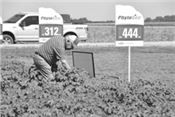|
Teamwork Preserves Cotton In Mississippi Hill Country

Award-winning farmer Paul Good examines cotton growing in Noxubee County during a
Mississippi State University field tour on July 12, 2017. Good said he remembers a time
when farmers did not grow cotton in the area, mostly because of boll weevils.
Photo by MSU Extension Service/Linda Breazeale
MACON, MISS.
Farmers’ independent natures make them strong, but when agricultural producers join forces, they can take success to the next level.
Darrin Dodds, cotton specialist with the Mississippi State University Extension Service, commended Mississippi farmers for their efforts to unite in the battle to eradicate boll weevils from the state.
“Historically, boll weevils were the prime pest in cotton fields. To control them, it took numerous pesticide applications,” he said. “Those treatments were costly and ate into the growers’ profit margins.”
Dodds said Mississippi has been weevil-free for eight years. In fact, boll weevil treatment in the United States is needed only in south Texas, which is near the pests’ native habitat in Mexico.
Cotton fields symbolized Mississippi agriculture for more than a century until boll weevils began to destroy farmers’ white gold. Boll weevil control was historically easier in the Delta, partly because overwintering populations of the pest were smaller there than in the hill section.
When the Southeastern Boll Weevil Eradication Program arrived in Mississippi in 1997, the first counties enrolled were two deep along the Alabama state line. A majority of cotton growers had to first vote the program into their regions. Later, 100 percent of the state’s cotton acres were committed to the effort.
Paul Good, 91, moved to Noxubee County in the early 1970s. For a time, area growers quit growing cotton, mostly because of the boll weevil, he said.
“The first year we returned to cotton, boll weevils were in it. In the ’80s, we sprayed and sprayed and still lost yields,” Good said. “We realized we needed the eradication program, and it has made a big difference.”
Good, the 2016 Swisher Sweets/Sunbelt Expo Southeastern Farmer of the Year for Mississippi, credits the eradication program, the MSU Extension Service and industry crop consultants who helped cotton make a strong comeback in the county. The MSU Row Crops Short Course, offered every December, has provided valuable information, he said.
Evidence of cotton’s return to prominence in the Mississippi hill section can be found at the Bogue Chitto Gin in Noxubee County. It is the only new gin to begin operating in Mississippi in five years.
Kerry Saylors of Dow AgroSciences took part in a Noxubee County Cotton Field Tour in July.
“Cotton would not have returned to these counties without high-yielding varieties and the new gin; the new gin wouldn’t be here if boll weevils still were, because there would still be very limited acres,” he said.
Aaron Litwiller, general manager of the gin, said they have increased the amount of cotton baled every year since the facility opened in 2012.
“Initially, our goal was to gin 30-40,000 bales each year. We baled 35,000 the first year, 36,000 the next, 55,000 in 2014 and 60,000 in 2015. Last year, we baled 95,000 and decided it was time for an expansion,” Litwiller said. “This year, we are anticipating a 40 percent increase in cotton acreage in our area.”
Litwiller said 75 percent of the cotton going through the gin comes from a 25-mile radius around Bogue Chitto. Nearly 100 producers from 15 counties in Mississippi and Alabama use the gin.
“The closest cotton is coming to the gin from our next-door neighbor, and the furthest is coming from a distance of 200 miles,” he said.
“We can’t say enough about what cotton has done for this area of Mississippi,” Litwiller said. “Irrigation has helped bring a lot of security to farming in the area.”
Dodds said an increase in access to irrigation has also helped growers in the hills.
“Noxubee farmers know their land and how to make it productive,” he said. “Clay soils are a challenge going from too wet to too dry.”
The success of growers in the hill section has contributed to the state’s bottom line.
“Mississippi cotton has yielded more than 1,000 pounds per acre for five years in a row, and more than 1,200 pounds for three out of the last five years,” Dodds said. “The consistent track record and respectable prices make a rise in acreage logical.” ∆
|
|